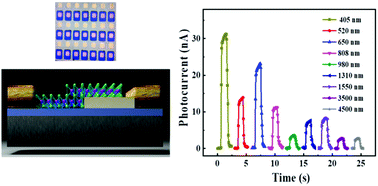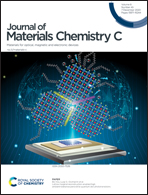A 3D topological Dirac semimetal/MoO3 thin film heterojunction infrared photodetector with a current reversal phenomenon†
Abstract
Photoelectric detection technology is extremely significant on account of its extensive applications in commercial and military fields, but high-performance array photodetectors based on Dirac semimetal thin film materials are rarely reported. Hence, we demonstrate photodetectors based on a three dimensional (3D) topological Dirac semimetal (DSM) (Cd1−xZnx)3As2/MoO3 array heterojunction, showing ultrahigh photoresponsivity, detectivity and external quantum efficiency in the ultra-broadband spectrum (405–4500 nm) of 3.1 A W−1, 6.4 × 1010 Jones and 855.8%, respectively, meanwhile possessing array unit performance repeatability and excellent time stability under atmospheric conditions at room temperature. The device exhibits an incredible current reversal phenomenon under the action of both light illumination and temperature variation elements, which can be attributed to a thermoelectromotive force effect. These excellent photoelectric properties illustrate that the fabrication of the 3D DSMs/inorganic thin film heterojunction is a suitable method for preparing distinguished infrared array photodetectors in the field of infrared telecommunications and scanning imaging.



 Please wait while we load your content...
Please wait while we load your content...